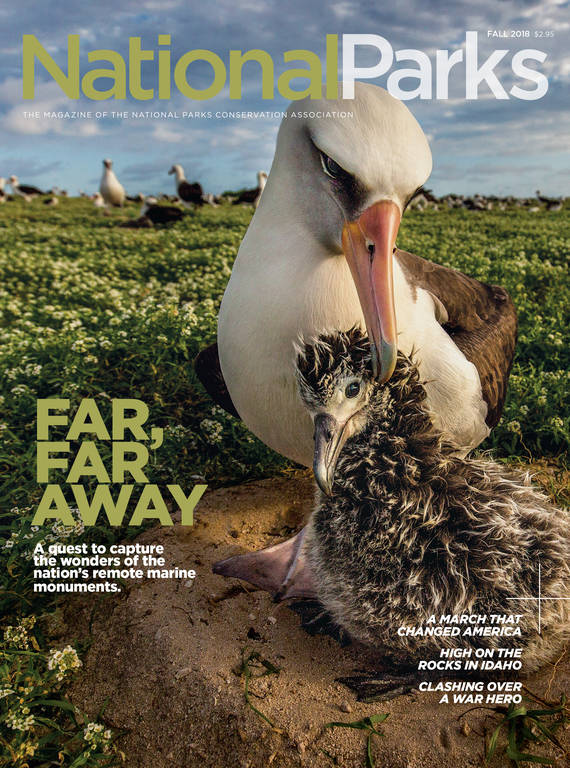Fall 2018
The Forgotten March
The 1932 veterans’ protest in Washington had a lasting impact on America but disappeared in the dustbin of history. The Park Service is working to change that.
On July 28, 1932, Gen. Douglas MacArthur stood on the Ellipse south of the White House in his uniform and stiff leather boots. As more than 200 cavalrymen, about 400 infantrymen and five tanks assembled nearby, he told Washington’s police chief that he would “break the back” of the enemy. MacArthur climbed inside a staff car, Maj. Dwight D. Eisenhower took his place in another and Maj. George S. Patton Jr. looked on from the height of his saddle. The three military leaders would later become celebrated heroes for fighting the German and Japanese armies during World War II. But on this summer afternoon during the Great Depression, they were up against a much more modest adversary: thousands of veterans who for two months had demonstrated peacefully in the nation’s capital, demanding wages for their service in World War I. They insisted they were asking for money they were owed rather than a bonus, but the movement soon became known as the Bonus Army, and the name stuck.
In Washington that day, the military marched on, herding vets and onlookers alike with bayonets. Someone threw a stone, and soldiers wearing gas masks responded by hurling tear-gas grenades. Soon, a gas cloud wafted over the crowd, sending men, women and children into uncontrolled fits of coughing and crying. Soldiers torched shanties that vets had built in abandoned buildings near Pennsylvania Avenue. “Most of the marchers gave way and fell back,” wrote Joseph C. Harsch, a journalist for The Christian Science Monitor. “In front of me, one stood his ground. A saber flashed in a swinging arc and grazed the cheek of the marcher. Blood flowed. The marcher backed away holding a hand to his bleeding ear.” As the soldiers paused on the west side of the Anacostia River, President Herbert Hoover sent an envoy to tell MacArthur to stop there, but the general disregarded the president’s command and ordered the troops to continue their march toward the protesters’ main camp on the other side of the river. Witnesses saw soldiers set the camp on fire as vets and their families rushed to salvage their meager belongings. According to one account, a soldier stabbed a boy in the leg as the child was trying to return to his burning shack to save his pet rabbit.
The next day, 3-year-old Bob Dillon climbed into his father’s car along with his mother and 4-year-old sister and traveled from the family’s home in Northern Virginia to the Anacostia Flats. Dillon’s father was a World War I veteran who walked with a limp after losing part of his kneecap in battle. Dillon said he’ll never know for sure, but he suspects that his father, although he had a good job as a government lawyer, sympathized with the demands of the bonus marchers and wanted his young children to see how the veterans were being treated by their fellow servicemen. Dillon still remembers seeing people picking through the rubble, and piles of rubbish smoldering hours after the blaze had lit up Washington’s sky. “I certainly remember the smell,” Dillon, one of the few living witnesses, said in a recent interview. “It was a terrible smell.”
The veterans never resorted to violence, but they could not avoid tragedy. During the protests, the malnourished 4-year-old son of a veteran died, and two protesters were killed in clashes with police. Less than two weeks after the evacuation, 3-month-old Bernard Myers, the son of a bonus marcher from Pennsylvania, died in a Washington hospital. His parents said the infant’s health had deteriorated after he inhaled tear gas. Countless marchers suffered injuries at the hands of the soldiers, and many lost their possessions in the fires. Yet for all the protesters’ sacrifices and efforts, a divided Congress did not pass the legislation granting them immediate compensation for their war service. As the veterans disbanded and settled in camps across the country, their campaign seemed a complete failure.
But in time, their protest would end up shaping America in profound and lasting ways. When reading his newspaper on the morning of July 29, Democratic presidential nominee Franklin D. Roosevelt, realizing how badly the events would reflect on Hoover, told an aide he was now assured of winning the election later that year. The prediction would prove to be correct, and Roosevelt’s victory would usher in an era of lasting social change.
Though the bonus marchers did not achieve their goal at the time, they showed it was possible to air their grievances publicly and peacefully. More than three decades later, Martin Luther King Jr. and his advisers looked at the Bonus Army’s tactics for inspiration as they planned their Poor People’s March on Washington, a multiracial protest that took place during the spring of 1968, shortly after King’s assassination. The vets’ ill-fated campaign also paved the way for legislation that would offer loan, mortgage and tuition benefits to millions of World War II veterans, significantly expand the country’s middle class and contribute to a period of unprecedented prosperity.
“It pretty much facilitated the G.I. Bill,” said Paul Dickson, co-author of a book about the movement titled “The Bonus Army: An American Epic,” “so it has a happy ending in that respect.”
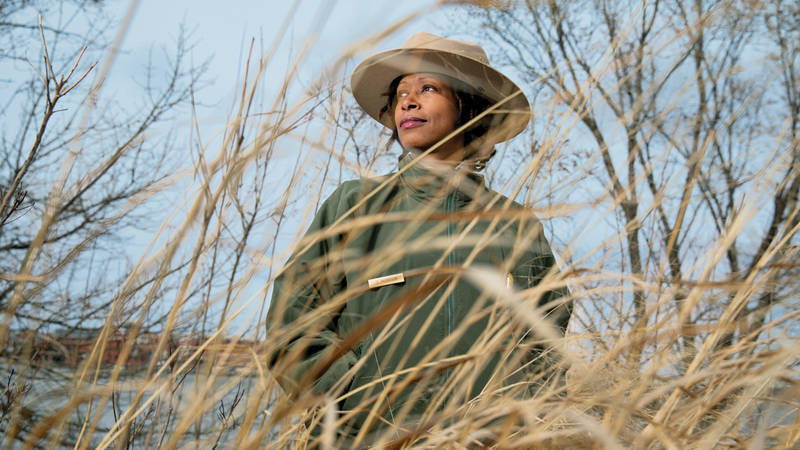
Superintendent Tara Morrison, who oversees Anacostia Park and other sites in the vicinity, wants visitors to learn about the important historic events that took place in the park.
© TYRONE TURNERToday, little remains of the passage of more than 40,000 veterans through Washington, D.C., other than two white marble tombstones at Arlington National Cemetery in nearby Virginia that mark the graves of the two veterans killed by police. Few remember the event itself, but the National Park Service is now working to resurrect this important part of the capital’s — and the nation’s — history. In Anacostia Park, the 1,100-acre riverside park where the veterans erected their shantytown, staff have started offering bike tours that retrace the steps of the protesters and are creating the first sign dedicated to the march.
“Most people visit Anacostia Park to recreate, but I think it’s important for people to be exposed to the significant events that took place here,” said Superintendent Tara Morrison, who also oversees several other sites in the vicinity.
The park, which is celebrating its centennial this year, includes land on both banks of the Anacostia River, a 9-mile-long tributary of the Potomac in the southeastern part of the city. Washington’s “forgotten river” has long been plagued by urban pollution, but decades of cleanups and new sewage infrastructure have some locals dreaming of soon swimming in the Anacostia — an activity that has been banned since the early 1970s. Visitors paddle on the river, jog or bike on the river banks, play soccer or flag football on the park’s athletic fields, or take a spin at the only roller skating rink in the National Park System. Locals and out-of-towners visit the park’s Kenilworth Aquatic Gardens to catch spectacular lotus and water lily blooms.
The park boasts a rich history. During a 2016 survey, archaeologists determined that 31 historic and prehistoric sites, some dating back about 10,000 years, lay within the borders of Anacostia Park. Shortly after Capt. John Smith explored the Anacostia in the early 17th century, the Nacotchtank Indians, who would later inspire the river’s current name, were displaced by English settlers and ravaged by disease. The river was a major trade route for tobacco until it silted up in the 18th century, and Anacostia became a residential community for workers at the nearby Navy Yard after it opened in 1799.
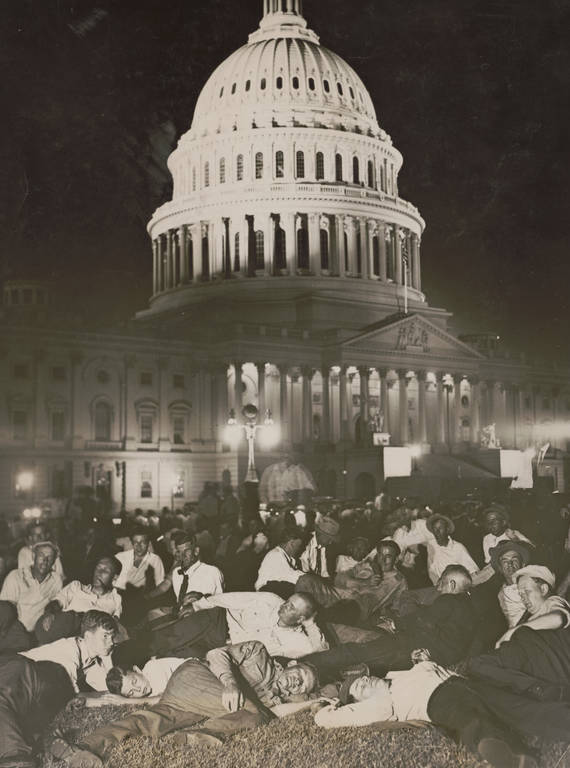
The bonus marchers, who were demanding wages for their service in World War I, spent the night in front of the U.S. Capitol on July 13, 1932.
Library of CongressIn 1877, famed abolitionist Frederick Douglass took advantage of a developer’s financial woes to buy a home in Anacostia, which was a predominantly white neighborhood at that time, and he would walk through what is now Anacostia Park every day on his way to his downtown office. (The house is cared for by the Park Service as the Frederick Douglass National Historic Site.)
During World War I, combat units of the U.S. Army were segregated. (One of two divisions of African American soldiers was loaned to the French Army, fought under the French flag and received numerous decorations for the soldiers’ valor in battle.) At the time the bonus marchers arrived in Washington, Anacostia Park also was segregated, and police directed the veterans to set up camp in the “black” section of the park. But the protest itself was fully integrated: African American veterans marched together with their white comrades. “I think it’s one of the things that made people fear this movement,” said Alan Spears, NPCA’s director of cultural resources.
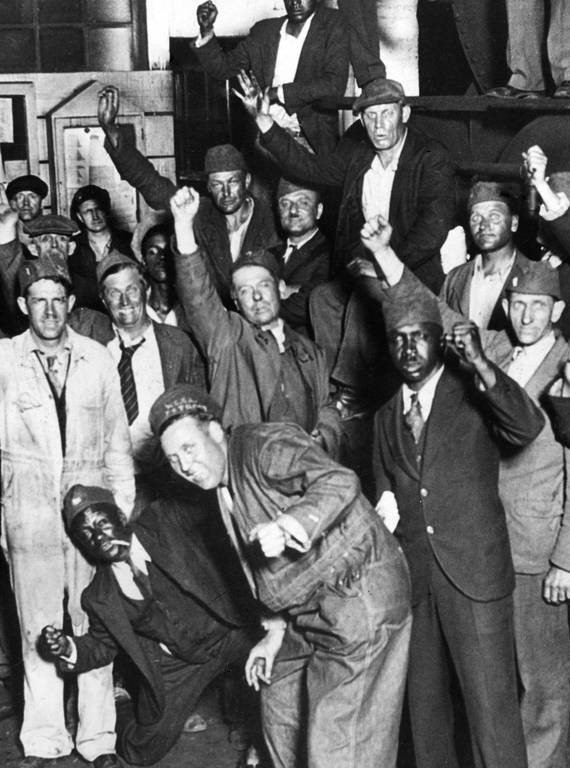
World War I veterans gathered in Cleveland, Ohio, in June 1932, before heading for Washington, D.C.
© SUEDDEUTSCHE ZEITUNG PHOTO/ALAMY STOCK PHOTOThe park’s role in the struggle for civil rights continued with the creation of a desegregated golf course in the late 1930s and the integration of the park’s public pool in 1949 when African Americans decided to patronize the pool despite facing intimidation and violence. Anacostia Park also indirectly played a role in the integration of the Washington Redskins, the last team in the National Football league to hire African American players. The owner was adamantly opposed to the integration of his team, but he relented when Stewart L. Udall, the secretary of the Interior, told him the Redskins could use the new stadium in Anacostia Park only if he followed federal laws prohibiting hiring discrimination.
Spears, who co-authored Anacostia Park’s brochure more than 15 years ago, said, “We had to make this twice as large as a regular park brochure because there was twice as much to put in.”
By the late 1960s, Anacostia was a vibrant, mostly African American community, said Spears, who grew up there. That changed in early April 1968 when people angered by King’s assassination looted businesses and burned down buildings. Riots erupted across the city, but Anacostia took longer to recover than many other neighborhoods, he said. During the city’s crack epidemic a couple of decades later, the neighborhood and park were hit hard by the crisis and associated violence. “People in the neighborhood weren’t going there,” Spears said of the park. “In the 1990s, it looked like a dangerous place to be.”
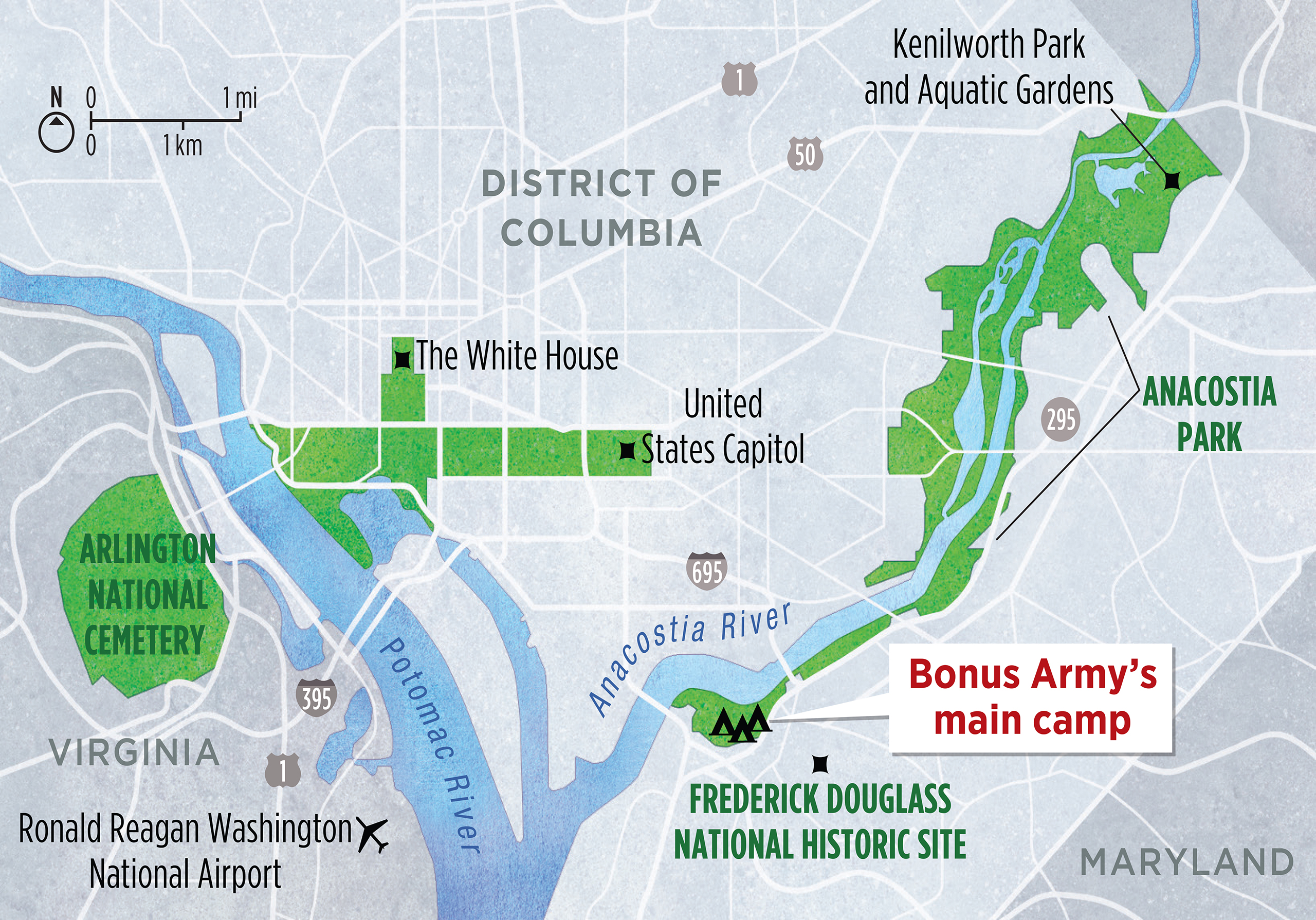
Safety has greatly improved, but tourists and many Washington residents still ignore “this side of the river,” said Vince Vaise, the chief of visitor services for Anacostia Park and other nearby park sites. Part of the problem is a lack of access. A freeway acts as a physical barrier between the park and the Anacostia neighborhood, and it’s difficult for pedestrians to reach the park from the other side of the river. The Park Service recently released a two-decade plan for the park that includes constructing additional entrances and boat launches. Separately, Building Bridges Across the River, a local nonprofit organization, is leading a project that also will improve access, creating a pedestrian park on the bridge the Army crossed to destroy the bonus marchers’ camp.
Another reason Anacostia Park is not on most tourists’ itineraries is a lack of awareness. Vaise, who took on his position in Washington two years ago after working for nearly three decades as a ranger at Baltimore’s Fort McHenry National Monument and Historic Shrine, is hoping to help change that.
Spears describes Vaise as one of the most dynamic and passionate rangers in the Park Service, and it’s easy to understand why. I heard his booming voice from the hall before I actually met him in his office at the park’s headquarters, and when he started talking about the Bonus Army, he became more animated still. Vaise became interested in history during his childhood, when his grandmother would tell him about the Great Depression, and the story of the bonus marchers especially moves him. “It just strikes me that you had this incredible social movement here, and there is no monument,” he said.
The park has undergone some change in the eight decades since the Bonus March. After we stepped outside, Vaise pointed to buildings that stand where the camp was erected and to the garage built on the dump where veterans collected refuse items to build their shacks. But elsewhere, the landscape is unaltered. The U.S. Capitol, just a little over 2 miles away, still towers over the skyline, and the grassy stretch along the river was never developed. Vaise led me to the stone embankment where veterans washed their white shirts before going to lobby members of Congress.
NPCA AT WORK
After World War I, many of the more than 4 million U.S. soldiers who survived the conflict found that others had taken their jobs and that civilian workers had enjoyed very large raises while the soldiers’ wages during the war had remained constant at $1 a day. Presidents Woodrow Wilson, Warren G. Harding and Calvin Coolidge all opposed the idea of compensating veterans beyond their wartime pay. In a compromise that satisfied no one and looked much like an attempt to pass the buck on to the next generation, Congress in 1924 passed a bill that awarded veterans adjusted compensation in 1945. Because the money could be paid to the veterans’ families earlier if they died, it was soon dubbed the “tombstone bonus.”
As the Great Depression hit and unemployment soared, calls for immediate payment of the bonus grew louder, but Hoover vetoed legislation to that effect, arguing that the large sums would require raising taxes — a worrying prospect in a faltering economy. In May 1932, nearly 300 veterans left Portland, Oregon, hopped on a freight train and headed east. The press covered their journey toward Washington, and soon thousands of others joined in, hitchhiking or traveling by truck, train or jalopy.
In the capital, the marchers found a sympathetic police chief in Pelham D. Glassford, himself a World War I veteran. Glassford helped the veterans find places to set up camp, met with them regularly and even used some of his own money to buy them food. On their end, protest leaders promised to keep their troops orderly and rout out Communist infiltrators. The close collaboration between police and protesters would set a new norm for demonstrations going forward. “Previously, it had been more of a hostile relationship, so this was definitely a shift,” said Lucy Barber, the author of “Marching on Washington: The Forging of an American Political Tradition.”
The veterans hung on long after the Senate failed to pass a House bill in mid-June, and by the end of July, the patience of D.C. commissioners and the Hoover administration was running low. They called for the ouster of the protesters, and federal troops were summoned. On July 28, the troops waited on standby outside Washington. The shooting of two veterans by police during the evacuation of a downtown building hastened the intervention by the military.
After the eviction, the authorities urged veterans to go back home, but many didn’t have a home to go back to. Some took up the offer of a small-town mayor in Pennsylvania who proposed to house them in an abandoned amusement park. Others settled in small camps in cities across the country. The veterans were dejected, but it quickly became evident that they at least had won the battle for public opinion. When newsreels of the rout by the Army appeared in movie theaters, the audience booed the soldiers attacking the marchers.
Later that year, Roosevelt won the election in a landslide, but he didn’t show more sympathy for the plight of the veterans than his predecessors and slashed their existing benefits to balance his budget. The Roosevelt administration did provide veterans with jobs in the South where they could work on construction projects for $1 a day, but the gesture was later marred by tragedy. When a hurricane was headed toward a veterans’ camp in the Florida Keys, supervisors failed to heed Coast Guard warnings and order the evacuation of the site. The camp’s flimsy structures were no match for the storm’s 200-mile-per-hour winds, and hundreds of veterans died.
Subsequently, in January 1936, a new bonus bill passed Congress. Roosevelt vetoed it, but both houses overrode his veto, and in June, the veterans finally received their money — $583 on average. Some quickly paid off their debts. Others bought cars, engagement rings or underwear.
As a much larger contingent of soldiers was preparing to come home from World War II, members of Congress and the president realized they couldn’t afford to treat them the way they had treated veterans of the Great War. “We must, this time, have plans ready,” Roosevelt said in his fireside chat on the 11th anniversary of the forced removal of the bonus marchers. “I have assured our men in the armed forces that the American people would not let them down when the war is won.”

National Parks
You can read this and other stories about history, nature, culture, art, conservation, travel, science and more in National Parks magazine. Your tax-deductible membership donation of $25 or more entitles…
See more ›Roosevelt signed the G.I. Bill on June 22, 1944, and more than 12 million World War II veterans benefited directly from the bill. Many wouldn’t have gone to college otherwise, and the sweeping law showed that higher education wasn’t reserved for America’s elites. “There is no question the G.I. Bill was one of the most enlightened pieces of legislation in American history,” said Glenn C. Altschuler, the co-author of “The G.I. Bill: A New Deal for Veterans.”
When Vaise led his first “Bonus Army” bike tour last year, participants knew little about the events of the summer of 1932, but when he asked them if they knew someone who had taken advantage of the G.I. Bill, nearly all raised their hands. Vaise likes to remind visitors that Anacostia Park is the “birthplace of the G.I. Bill.” It’s also a place, he tells them, where people who felt strongly about the righteousness of their cause were willing to face bodily harm to defend it.
“Places that forced social change are like battlefields. They are worthy of being remembered,” he said. “This is just as valuable a piece of land as Gettysburg.”
About the author
-
 Nicolas Brulliard Senior Editor
Nicolas Brulliard Senior EditorNicolas is a journalist and former geologist who joined NPCA in November 2015. He serves as senior editor of National Parks magazine.
